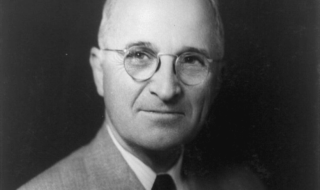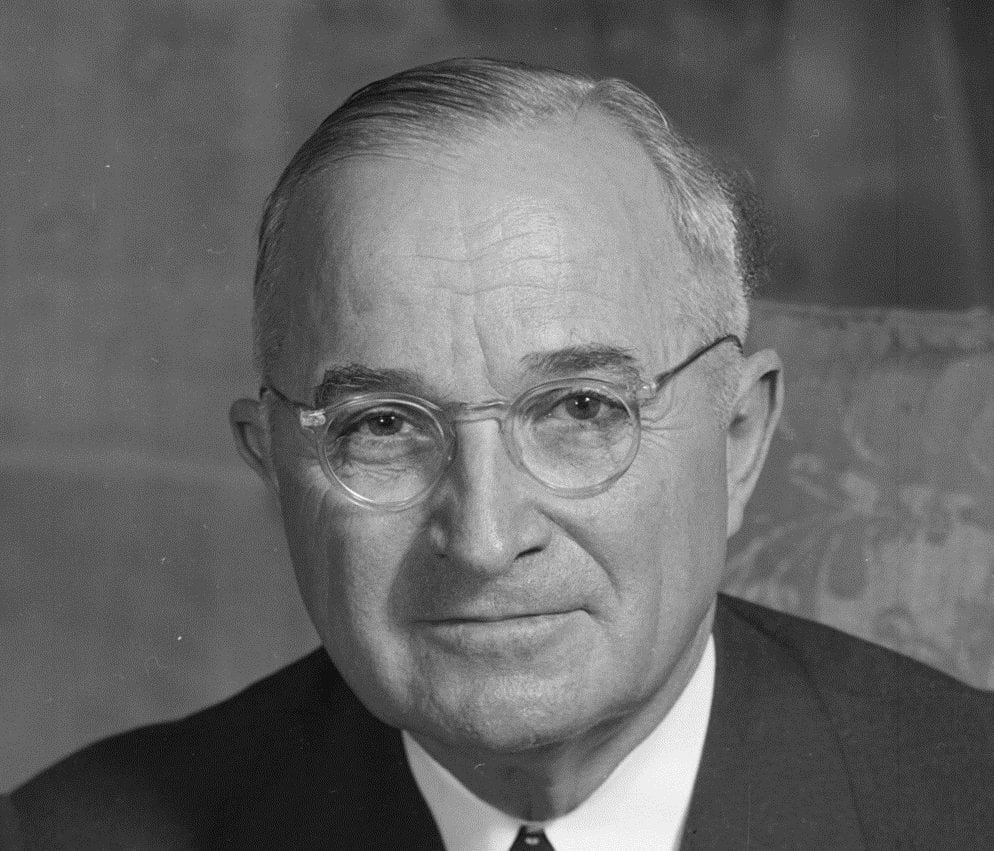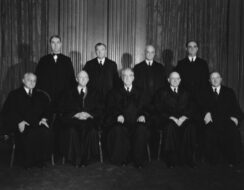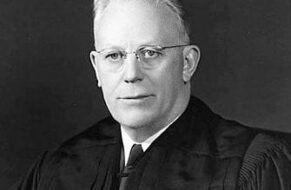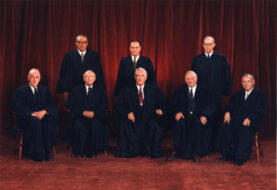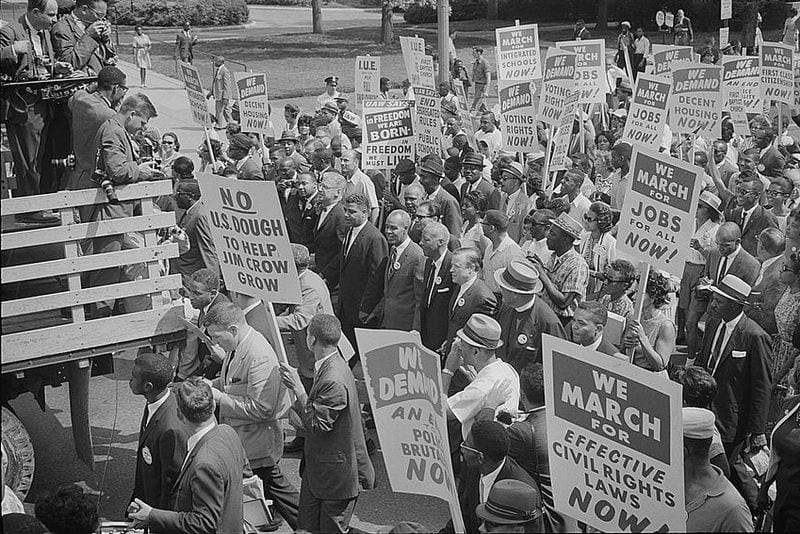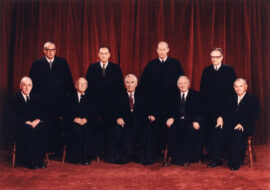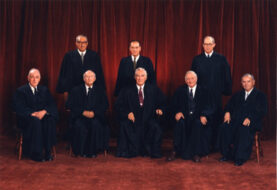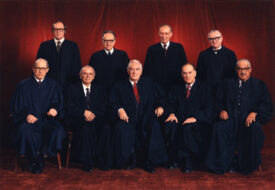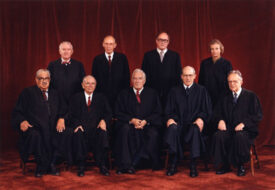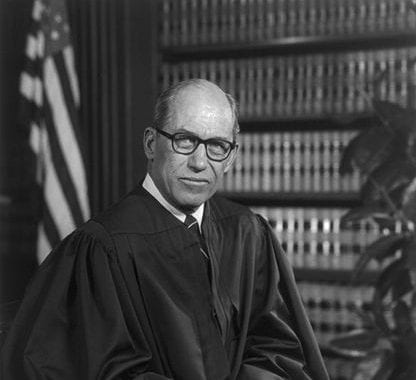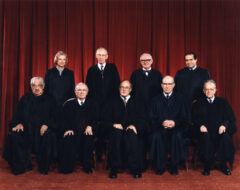

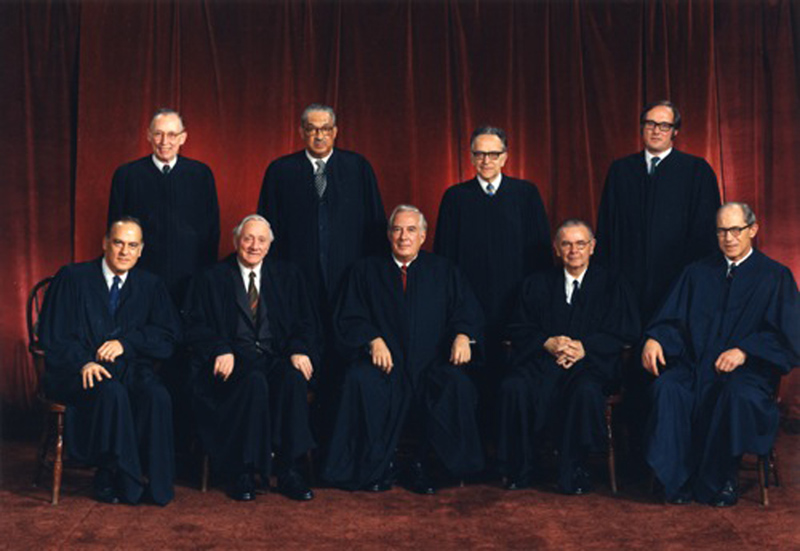
No related resources
Introduction
In 1965 the Supreme Court decided the case of Griswold v. Connecticut, which held that married couples have an implicit constitutional right to use contraceptives found in the “penumbras, formed by emanations” from specific guarantees such as the Fourth, Fifth, Ninth, and Fourteenth Amendments. In Eisenstadt v. Baird (1972), the Court clarified that the right to contraceptives belongs not to couples as such but to the individuals (married or unmarried) who make up the couple. The Court located such a right in a right of privacy, not among those enumerated in the Constitution, which, if it “means anything, is the right of the individual, married or single, to be free from unwarranted governmental intrusion into matters so fundamentally affecting a person as the decision whether to bear or beget a child.”
This decision (among others) laid the groundwork for Roe v. Wade, handed down a year later. A pregnant single woman (“Jane Roe” was a pseudonym for Norma McCorvey) in Dallas, Texas, brought a class action challenging the constitutionality of Texas’s criminal abortion laws. The laws—like those of more than thirty states—prohibited procuring or attempting an abortion except on medical advice for the purpose of saving the mother’s life. The statutes were enforced in Dallas by the county district attorney Henry Wade, who became a named party in the suit. A three-judge district court declared the abortion statutes void as vague and overbroadly infringing Roe’s Ninth and Fourteenth Amendment rights. Both sides appealed to the United States Court of Appeals for the Fifth Circuit, which ordered the appeals held in abeyance pending decision by the US Supreme Court. The Court first took the case in 1970 and, after the 1971 retirements of Justices John Marshall Harlan II and Hugo Black, the Court reheard arguments and finally handed down its decision in favor of Roe in January 1973, not long after the Eisenstadt v Baird decision. By a 7-2 vote, Roe invalidated the abortion laws of many states.
Despite the seven-vote majority, Roe v. Wade was immediately controversial and has remained so for nearly fifty years. For supporters, it is a sacrosanct precedent entitled to the same level of constitutional authority as cases like Brown v. Board of Education. For critics, Roe is akin to the Court’s infamous decision in Dred Scott v. Sandford and should be overturned. Its central holding on a constitutional right to abortion continues, but it has not settled the political or legal controversy over the practice. Many states have continued to regulate and even limit abortion, which has resulted in a number of cases involving the meaning of Roe. In Planned Parenthood v. Casey (1992), for example, four Supreme Court justices voted to maintain Roe in its entirety, two voted to overturn it entirely, and three voted to maintain the central holding but abandon the trimester framework in favor of considering whether a law imposes an “undue burden” on the right to abortion. Over the next decade, the “undue burden” test replaced Roe’s trimester framework and was used in Gonzales v. Carhart (2007) to uphold a federal law banning partial birth abortions.
Source: 410 U.S. 113; https://www.law.cornell.edu/supremecourt/text/410/113. For Justice White’s dissent, issued with Doe v. Bolton, 410 U.S. 179: https://www.law.cornell.edu/supremecourt/text/410/179#writing-USSC_CR_0410_0179_ZD.
Justice BLACKMUN delivered the Opinion of the Court, joined by Chief Justice BURGER and Justices DOUGLAS, BRENNAN, STEWART, MARSHALL, and POWELL.
. . . We forthwith acknowledge our awareness of the sensitive and emotional nature of the abortion controversy, of the vigorous opposing views, even among physicians, and of the deep and seemingly absolute convictions that the subject inspires. One’s philosophy, one’s experiences, one’s exposure to the raw edges of human existence, one’s religious training, one’s attitudes toward life and family and their values, and the moral standards one establishes and seeks to observe, are all likely to influence and to color one’s thinking and conclusions about abortion.
In addition, population growth, pollution, poverty, and racial overtones tend to complicate and not to simplify the problem.
Our task, of course, is to resolve the issue by constitutional measurement, free of emotion and of predilection. We seek earnestly to do this, and, because we do, we have inquired into, and in this opinion place some emphasis upon, medical and medical-legal history and what that history reveals about man’s attitudes toward the abortion procedure over the centuries. . . .
The Texas statutes that concern us here . . . make it a crime to “procure an abortion,” as therein defined, or to attempt one, except with respect to “an abortion procured or attempted by medical advice for the purpose of saving the life of the mother.” Similar statutes are in existence in a majority of the States.
Texas first enacted a criminal abortion statute in 1854. This was soon modified into language that has remained substantially unchanged to the present time. . . .
The principal thrust of [Jane Roe’s] attack on the Texas statutes is that they improperly invade a right, said to be possessed by the pregnant woman, to choose to terminate her pregnancy. [Roe] would discover this right in the concept of personal “liberty” embodied in the Fourteenth Amendment’s Due Process Clause; or in personal, marital, familial, and sexual privacy said to be protected by the Bill of Rights or its penumbras, see Griswold v. Connecticut (1965); Eisenstadt v. Baird (1972); or among those rights reserved to the people by the Ninth Amendment, Griswold v. Connecticut (Justice Goldberg, concurring). Before addressing this claim, we feel it desirable briefly to survey, in several aspects, the history of abortion, for such insight as that history may afford us, and then to examine the state purposes and interests behind the criminal abortion laws.
It perhaps is not generally appreciated that the restrictive criminal abortion laws in effect in a majority of States today are of relatively recent vintage. Those laws, generally proscribing abortion or its attempt at any time during pregnancy except when necessary to preserve the pregnant woman’s life, are not of ancient or even of common law origin. Instead, they derive from statutory changes effected, for the most part, in the latter half of the 19th century.
. . . It is undisputed that, at common law, abortion performed before “quickening”—the first recognizable movement of the fetus in utero, appearing usually from the 16th to the 18th week of pregnancy—was not an indictable offense. . . . [P]rior to this point, the fetus was to be regarded as part of the mother, and its destruction, therefore, was not homicide. . . .
Whether abortion of a quick fetus was a felony at common law, or even a lesser crime, is still disputed. . . .
. . . In this country, the law in effect in all but a few States until mid-19th century was the pre-existing English common law. . . . It was not until after the War Between the States that legislation began generally to replace the common law. Most of these initial statutes dealt severely with abortion after quickening, but were lenient with it before quickening. Most punished attempts equally with completed abortions. While many statutes included the exception for an abortion thought by one or more physicians to be necessary to save the mother’s life, that provision soon disappeared, and the typical law required that the procedure actually be necessary for that purpose. Gradually, in the middle and late 19th century, the quickening distinction disappeared from the statutory law of most States and the degree of the offense and the penalties were increased. By the end of the 1950s, a large majority of the jurisdictions banned abortion, however and whenever performed, unless done to save or preserve the life of the mother. . . . In the past several years, however, a trend toward liberalization of abortion statutes has resulted in adoption, by about one-third of the States, of less stringent laws. . . .
It is thus apparent that, at common law, at the time of the adoption of our Constitution, and throughout the major portion of the 19th century, abortion was viewed with less disfavor than under most American statutes currently in effect. Phrasing it another way, a woman enjoyed a substantially broader right to terminate a pregnancy than she does in most States today. At least with respect to the early stage of pregnancy, and very possibly without such a limitation, the opportunity to make this choice was present in this country well into the 19th century. Even later, the law continued for some time to treat less punitively an abortion procured in early pregnancy. . . .
Three reasons have been advanced to explain historically the enactment of criminal abortion laws in the 19th century and to justify their continued existence.
It has been argued occasionally that these laws were the product of a Victorian social concern to discourage illicit sexual conduct. Texas, however, does not advance this justification in the present case, and it appears that no court or commentator has taken the argument seriously. The appellants[1] and amici[2] contend, moreover, that this is not a proper state purpose at all, and suggest that, if it were, the Texas statutes are overbroad in protecting it, since the law fails to distinguish between married and unwed mothers.
A second reason is concerned with abortion as a medical procedure. When most criminal abortion laws were first enacted, the procedure was a hazardous one for the woman. . . . Thus, it has been argued that a State’s real concern in enacting a criminal abortion law was to protect the pregnant woman, that is, to restrain her from submitting to a procedure that placed her life in serious jeopardy.
Modern medical techniques have altered this situation. . . . [M]edical data indicat[e] that abortion in early pregnancy, that is, prior to the end of the first trimester, although not without its risk, is now relatively safe. Mortality rates for women undergoing early abortions, where the procedure is legal, appear to be as low as or lower than the rates for normal childbirth. Consequently, any interest of the State in protecting the woman from an inherently hazardous procedure, except when it would be equally dangerous for her to forgo it, has largely disappeared. Of course, important state interests in the areas of health and medical standards do remain. The State has a legitimate interest in seeing to it that abortion, like any other medical procedure, is performed under circumstances that insure maximum safety for the patient. . . .
The third reason is the State’s interest—some phrase it in terms of duty—in protecting prenatal life. Some of the argument for this justification rests on the theory that a new human life is present from the moment of conception. The State’s interest and general obligation to protect life then extends, it is argued, to prenatal life. Only when the life of the pregnant mother herself is at stake, balanced against the life she carries within her, should the interest of the embryo or fetus not prevail. Logically, of course, a legitimate state interest in this area need not stand or fall on acceptance of the belief that life begins at conception or at some other point prior to live birth. In assessing the State’s interest, recognition may be given to the less rigid claim that as long as at least potential life is involved, the State may assert interests beyond the protection of the pregnant woman alone. . . .
It is with these interests, and the weight to be attached to them, that this case is concerned.
The Constitution does not explicitly mention any right of privacy. In a line of decisions, however, . . . the Court has recognized that a right of personal privacy, or a guarantee of certain areas or zones of privacy, does exist under the Constitution. In varying contexts, the Court or individual Justices have, indeed, found at least the roots of that right in the First Amendment; in the Fourth and Fifth Amendments; in the penumbras of the Bill of Rights; in the Ninth Amendment; or in the concept of liberty guaranteed by the first section of the Fourteenth Amendment. These decisions make it clear that only personal rights that can be deemed “fundamental” or “implicit in the concept of ordered liberty” (Palko v. Connecticut [1937]), are included in this guarantee of personal privacy. They also make it clear that the right has some extension to activities relating to marriage (Loving v. Virginia [1967]), procreation (Skinner v. Oklahoma [1942]), contraception (Eisenstadt v. Baird [1972]), . . . and child rearing and education (Pierce v. Society of Sisters [1925]).
This right of privacy, whether it be founded in the Fourteenth Amendment’s concept of personal liberty and restrictions upon state action, as we feel it is, or . . . in the Ninth Amendment’s reservation of rights to the people, is broad enough to encompass a woman’s decision whether or not to terminate her pregnancy. The detriment that the State would impose upon the pregnant woman by denying this choice altogether is apparent. Specific and direct harm medically diagnosable even in early pregnancy may be involved. Maternity, or additional offspring, may force upon the woman a distressful life and future. Psychological harm may be imminent. Mental and physical health may be taxed by child care. There is also the distress, for all concerned, associated with the unwanted child, and there is the problem of bringing a child into a family already unable, psychologically and otherwise, to care for it. In other cases, as in this one, the additional difficulties and continuing stigma of unwed motherhood may be involved. All these are factors the woman and her responsible physician necessarily will consider in consultation.
On the basis of elements such as these, . . . some argue that the woman’s right is absolute and that she is entitled to terminate her pregnancy at whatever time, in whatever way, and for whatever reason she alone chooses. With this we do not agree. . . . The Court’s decisions recognizing a right of privacy also acknowledge that some state regulation in areas protected by that right is appropriate. As noted above, a State may properly assert important interests in safeguarding health, in maintaining medical standards, and in protecting potential life. At some point in pregnancy, these respective interests become sufficiently compelling to sustain regulation of the factors that govern the abortion decision. The privacy right involved, therefore, cannot be said to be absolute. . . .
We, therefore, conclude that the right of personal privacy includes the abortion decision, but that this right is not unqualified and must be considered against important state interests in regulation. . . .
Where certain “fundamental rights” are involved, the Court has held that regulation limiting these rights may be justified only by a “compelling state interest” (Sherbert v. Verner [1963]), and that legislative enactments must be narrowly drawn to express only the legitimate state interests at stake Griswold v. Connecticut [1965]). . . .
[Wade] and certain amici argue that the fetus is a “person” within the language and meaning of the Fourteenth Amendment. In support of this, they outline at length and in detail the well known facts of fetal development. If this suggestion of personhood is established, [Roe’s] case, of course, collapses, for the fetus’ right to life would then be guaranteed specifically by the Amendment. . . .
The Constitution does not define “person” in so many words. Section 1 of the Fourteenth Amendment contains three references to “person.” The first, in defining “citizens,” speaks of “persons born or naturalized in the United States.” The word also appears both in the Due Process Clause and in the Equal Protection Clause. “Person” is used in other places in the Constitution: in the listing of qualifications for Representatives and Senators, Article I, section 2; in the Apportionment Clause, Article I, section 2; in the Migration and Importation provision, Article I, section 9; in the Emolument Clause, Article I, section 9; in the Electors provisions, Article II, section 1; in the provision outlining qualifications for the office of President, Article II, section 1; in the Extradition provisions, Article IV, section 2, and the superseded Fugitive Slave Clause section 3; and in the Fifth, Twelfth, and Twenty-second Amendments, as well as in sections 2 and 3 of the Fourteenth Amendment. But in nearly all these instances, the use of the word is such that it has application only post-natally. None indicates, with any assurance, that it has any possible pre-natal application.
All this, together with our observation, supra that throughout the major portion of the 19th century, prevailing legal abortion practices were far freer than they are today, persuades us that the word “person,” as used in the Fourteenth Amendment, does not include the unborn. . . .
. . . [H]owever . . . [t]he pregnant woman cannot be isolated in her privacy. She carries an embryo and, later, a fetus, if one accepts the medical definitions of the developing young in the human uterus. The situation therefore is inherently different from marital intimacy, or bedroom possession of obscene material, or marriage, or procreation, or education. . . . As we have intimated above, it is reasonable and appropriate for a State to decide that at some point in time another interest, that of health of the mother or that of potential human life, becomes significantly involved. The woman’s privacy is no longer sole and any right of privacy she possesses must be measured accordingly.
Texas urges that, apart from the Fourteenth Amendment, life begins at conception and is present throughout pregnancy, and that, therefore, the State has a compelling interest in protecting that life from and after conception. We need not resolve the difficult question of when life begins. When those trained in the respective disciplines of medicine, philosophy, and theology are unable to arrive at any consensus, the judiciary, at this point in the development of man’s knowledge, is not in a position to speculate as to the answer. . . .
In areas other than criminal abortion, the law has been reluctant to endorse any theory that life, as we recognize it, begins before live birth or to accord legal rights to the unborn except in narrowly defined situations and except when the rights are contingent upon live birth. . . .
In view of all this, we do not agree that, by adopting one theory of life, Texas may override the rights of the pregnant woman that are at stake. We repeat, however, that the State does have an important and legitimate interest in preserving and protecting the health of the pregnant woman, whether she be a resident of the State or a nonresident who seeks medical consultation and treatment there, and that it has still another important and legitimate interest in protecting the potentiality of human life. These interests are separate and distinct. Each grows in substantiality as the woman approaches term and, at a point during pregnancy, each becomes “compelling.”
With respect to the State’s important and legitimate interest in the health of the mother, the “compelling” point, in the light of present medical knowledge, is at approximately the end of the first trimester. This is so because of the now-established medical fact . . . that, until the end of the first trimester, mortality in abortion may be less than mortality in normal childbirth. It follows that, from and after this point, a State may regulate the abortion procedure to the extent that the regulation reasonably relates to the preservation and protection of maternal health. Examples of permissible state regulation in this area are requirements as to the qualifications of the person who is to perform the abortion; as to the licensure of that person; as to the facility in which the procedure is to be performed, that is, whether it must be a hospital or may be a clinic or some other place of less-than-hospital status; as to the licensing of the facility; and the like.
This means, on the other hand, that, for the period of pregnancy prior to this “compelling” point, the attending physician, in consultation with his patient, is free to determine, without regulation by the State, that, in his medical judgment, the patient’s pregnancy should be terminated. If that decision is reached, the judgment may be effectuated by an abortion free of interference by the State.
With respect to the State’s important and legitimate interest in potential life, the “compelling” point is at viability. This is so because the fetus then presumably has the capability of meaningful life outside the mother’s womb. State regulation protective of fetal life after viability thus has both logical and biological justifications. If the State is interested in protecting fetal life after viability, it may go so far as to proscribe abortion during that period, except when it is necessary to preserve the life or health of the mother.
Measured against these standards, the Texas Penal Code, in restricting legal abortions to those “procured or attempted by medical advice for the purpose of saving the life of the mother,” sweeps too broadly. The statute makes no distinction between abortions performed early in pregnancy and those performed later, and it limits to a single reason, “saving” the mother’s life, the legal justification for the procedure. The statute, therefore, cannot survive the constitutional attack made upon it here. . . .
To summarize and to repeat:
- A state criminal abortion statute of the current Texas type, that excepts from criminality only a life-saving procedure on behalf of the mother, without regard to pregnancy stage and without recognition of the other interests involved, is violative of the Due Process Clause of the Fourteenth Amendment.
(a) For the stage prior to approximately the end of the first trimester, the abortion decision and its effectuation must be left to the medical judgment of the pregnant woman’s attending physician.
(b) For the stage subsequent to approximately the end of the first trimester, the State, in promoting its interest in the health of the mother, may, if it chooses, regulate the abortion procedure in ways that are reasonably related to maternal health.
(c) For the stage subsequent to viability, the State in promoting its interest in the potentiality of human life may, if it chooses, regulate, and even proscribe, abortion except where it is necessary, in appropriate medical judgment, for the preservation of the life or health of the mother.
- The State may define the term “physician” . . . to mean only a physician currently licensed by the State, and may proscribe any abortion by a person who is not a physician as so defined. . . .
Our conclusion that Article 1196 is unconstitutional means, of course, that the Texas abortion statutes, as a unit, must fall. . . .
It is so ordered.
Justice STEWART, concurring.
. . . The Constitution nowhere mentions a specific right of personal choice in matters of marriage and family life, but the “liberty” protected by the Due Process Clause of the Fourteenth Amendment covers more than those freedoms explicitly named in the Bill of Rights. . . .
Several decisions of this Court make clear that freedom of personal choice in matters of marriage and family life is one of the liberties protected by the Due Process Clause of the Fourteenth Amendment. . . . As recently as last Term, in Eisenstadt v. Baird (1972), we recognized “the right of the individual, married or single, to be free from unwarranted governmental intrusion into matters so fundamentally affecting a person as the decision whether to bear or beget a child.” That right necessarily includes the right of a woman to decide whether or not to terminate her pregnancy. . . .
It is evident that the Texas abortion statute infringes that right directly. Indeed, it is difficult to imagine a more complete abridgment of a constitutional freedom than that worked by the inflexible criminal statute now in force in Texas. The question then becomes whether the state interests advanced to justify this abridgment can survive the “particularly careful scrutiny” that the Fourteenth Amendment here requires.
The asserted state interests are protection of the health and safety of the pregnant woman, and protection of the potential future human life within her. These are legitimate objectives, amply sufficient to permit a State to regulate abortions as it does other surgical procedures, and perhaps sufficient to permit a State to regulate abortions more stringently or even to prohibit them in the late stages of pregnancy. But such legislation is not before us, and I think the Court today has thoroughly demonstrated that these state interests cannot constitutionally support the broad abridgment of personal liberty worked by the existing Texas law. Accordingly, I join the Court’s opinion holding that that law is invalid under the Due Process Clause of the Fourteenth Amendment.
Justice REHNQUIST, dissenting.
The Court’s opinion brings to the decision of this troubling question both extensive historical fact and a wealth of legal scholarship. While the opinion thus commands my respect, I find myself nonetheless in fundamental disagreement with those parts of it that invalidate the Texas statute in question, and therefore dissent. . . ..
. . . I have difficulty in concluding, as the Court does, that the right of “privacy” is involved in this case. Texas, by the statute here challenged, bars the performance of a medical abortion by a licensed physician on a plaintiff such as Roe. A transaction resulting in an operation such as this is not “private” in the ordinary usage of that word. Nor is the “privacy” that the Court finds here even a distant relative of the freedom from searches and seizures protected by the Fourth Amendment to the Constitution, which the Court has referred to as embodying a right to privacy (Katz v. United States [1967]).[3]
[4]If the Court means by the term “privacy” no more than that the claim of a person to be free from unwanted state regulation of consensual transactions may be a form of “liberty” protected by the Fourteenth Amendment, there is no doubt that similar claims have been upheld in our earlier decisions on the basis of that liberty. . . . But that liberty is not guaranteed absolutely against deprivation, only against deprivation without due process of law. The test traditionally applied in the area of social and economic legislation is whether or not a law such as that challenged has a rational relation to a valid state objective. The Due Process Clause of the Fourteenth Amendment undoubtedly does place a limit, albeit a broad one, on legislative power to enact laws such as this. If the Texas statute were to prohibit an abortion even where the mother’s life is in jeopardy, I have little doubt that such a statute would lack a rational relation to a valid state objective. . . . But the Court’s sweeping invalidation of any restrictions on abortion during the first trimester is impossible to justify under that standard, and the conscious weighing of competing factors that the Court’s opinion apparently substitutes for the established test is far more appropriate to a legislative judgment than to a judicial one. . . .
. . . The decision here to break pregnancy into three distinct terms and to outline the permissible restrictions the State may impose in each one, for example, partakes more of judicial legislation than it does of a determination of the intent of the drafters of the Fourteenth Amendment.
The fact that a majority of the States reflecting, after all, the majority sentiment in those States, have had restrictions on abortions for at least a century is a strong indication, it seems to me, that the asserted right to an abortion is not “so rooted in the traditions and conscience of our people as to be ranked as fundamental” (Snyder v. Massachusetts [1934]). Even today, when society’s views on abortion are changing, the very existence of the debate is evidence that the “right” to an abortion is not so universally accepted as [Roe] would have us believe.
To reach its result, the Court necessarily has had to find within the scope of the Fourteenth Amendment a right that was apparently completely unknown to the drafters of the Amendment. . . . By the time of the adoption of the Fourteenth Amendment in 1868, there were at least 36 laws enacted by state or territorial legislatures limiting abortion. While many States have amended or updated their laws, 21 of the laws on the books in 1868 remain in effect today. Indeed, the Texas statute struck down today was, as the majority notes, first enacted in 1857 and “has remained substantially unchanged to the present time.”
There apparently was no question concerning the validity of this provision or of any of the other state statutes when the Fourteenth Amendment was adopted. The only conclusion possible from this history is that the drafters did not intend to have the Fourteenth Amendment withdraw from the States the power to legislate with respect to this matter. . . .
For all of the foregoing reasons, I respectfully dissent.
Justice WHITE dissenting, joined by Justice REHNQUIST.
At the heart of the controversy in these cases are those recurring pregnancies that pose no danger whatsoever to the life or health of the mother but are, nevertheless, unwanted for any one or more of a variety of reasons—convenience, family planning, economics, dislike of children, the embarrassment of illegitimacy, etc. The common claim before us is that, for any one of such reasons, or for no reason at all, and without asserting or claiming any threat to life or health, any woman is entitled to an abortion at her request if she is able to find a medical advisor willing to undertake the procedure.
The Court, for the most part, sustains this position: during the period prior to the time the fetus becomes viable, the Constitution of the United States values the convenience, whim, or caprice of the putative mother more than the life or potential life of the fetus; the Constitution, therefore, guarantees the right to an abortion as against any state law or policy seeking to protect the fetus from an abortion not prompted by more compelling reasons of the mother.
With all due respect, I dissent. I find nothing in the language or history of the Constitution to support the Court’s judgment. The Court simply fashions and announces a new constitutional right for pregnant mothers and, with scarcely any reason or authority for its action, invests that right with sufficient substance to override most existing state abortion statutes. The upshot is that the people and the legislatures of the 50 States are constitutionally disentitled to weigh the relative importance of the continued existence and development of the fetus, on the one hand, against a spectrum of possible impacts on the mother, on the other hand. As an exercise of raw judicial power, the Court perhaps has authority to do what it does today; but, in my view, its judgment is an improvident and extravagant exercise of the power of judicial review that the Constitution extends to this Court.
. . . In a sensitive area such as this, involving as it does issues over which reasonable men may easily and heatedly differ, I cannot accept the Court’s exercise of its clear power of choice by interposing a constitutional barrier to state efforts to protect human life and by investing mothers and doctors with the constitutionally protected right to exterminate it. This issue, for the most part, should be left with the people and to the political processes the people have devised to govern their affairs.
It is my view, therefore, that the Texas statute is not constitutionally infirm because it denies abortions to those who seek to serve only their convenience, rather than to protect their life or health. Nor is this plaintiff, who claims no threat to her mental or physical health, entitled to assert the possible rights of those women whose pregnancy assertedly implicates their health. . .

Conversation-based seminars for collegial PD, one-day and multi-day seminars, graduate credit seminars (MA degree), online and in-person.






